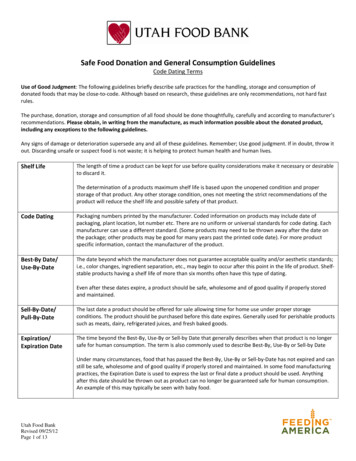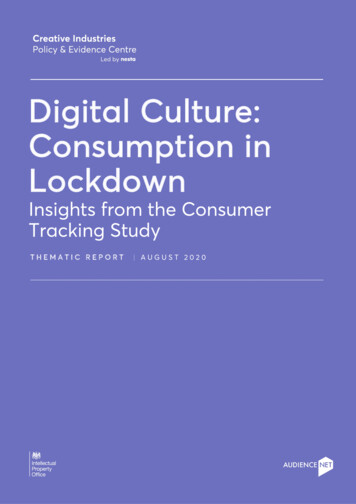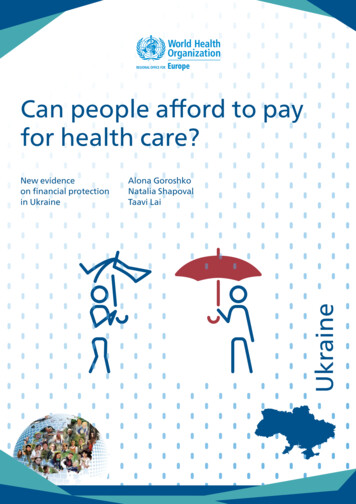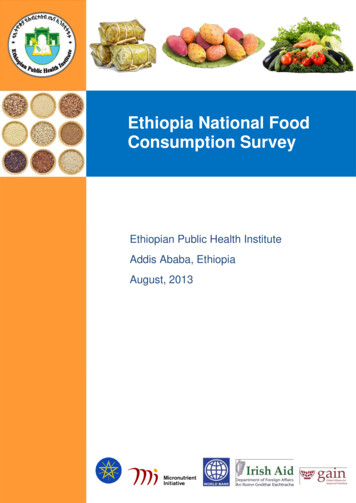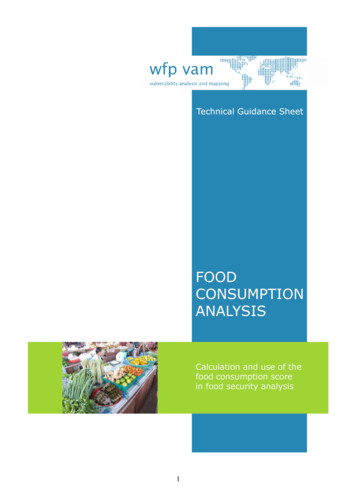
Transcription
1
Food consumption analysisCalculation and use of the food consumption score in food securityanalysis.Prepared by VAM unit HQ Rome.Version 1February 2008 World Food Programme, Vulnerability Analysis and Mapping Branch (ODAV)Picture: 2006 WFP/Andrea BerardoThis study was prepared under the umbrella of the “Strengthening EmergencyNeeds Assessment Capacity” (SENAC). Financial support for this study wasprovided by European Union and the Citigroup Foundation. The views expressedherein can in no way be taken to reflect the official opinion of the European Unionor the Citigroup Foundation.For any queries on this document or the SENAC project, please contactODAN info@wfp.org or visit www.wfp.org/odan/senacFor information about the VAM Unit, please visit: http://vam.wfp.orgUnited Nations World Food ProgrammeHeadquarters: Via C.G. Viola 68, Parco de’ Medici, 00148, Rome, Italy2
Table of Contents1. Introduction 42. Background 42.1 Past analyses of food consumption 52.2 New standard methodology 53. Purpose of this document 64. Current use of the FCS 65. Calculation of the Food Consumption Score (FCS) and FoodConsumption Groups (FCGs) 86. Analysis of food consumption 97. Validation of the FCS and FCGs as a proxy indicator of Food Security. 138. Considerations when using the FCS/FCGs in non CFSVA contexts 159. Discussion on key points of the FCS/FCG 169.1 Food consumption data collection module 169.2 Food items and food groups 179.3 Measuring and estimating actual quantities of food eaten 189.4 Recall period for food frequency and diversity 189.5 Food frequency- Number of days vs. number of times 199.6 How the weights were determined 199.7 How the FCG cut-offs were selected, and what it means to changethem 209.8 Issues with sugar and oil and changing the thresholds. 219.9 Effect and how to handle condiments in data collection and inanalysis 2410. Papers on the FCS and Upcoming validation studies. 243
1. IntroductionThere is no single way to measure food security, the concept itself being ratherelusive. Analysis of food security by WFP generally uses food consumption as theentry point. Food consumption measured in kilocalories is the gold standard formeasuring consumption, and often considered to be one of the gold standards forfood security- but the collection of detailed food intake data is difficult and timeconsuming.WFP’s goal is to have a standard food consumption data collection instrument andanalysis approach that is flexible enough for different needs and contexts, whilestandard enough to have equally applicable analysis techniques and equallyinterpretable results, and also one that can be implemented in the field in areasonable data collection and analysis timeframe. There are several alternativeways to collect and analyze food consumption information using indicators thatare proxy for actual caloric intake and diet quality.Such proxies generally include information on dietary diversity, sometimes withthe addition of food frequency. WFP has adopted this data collection toolmeasuring dietary diversity and food frequency - because several differentindicators built on this sort of data have proven to be strong proxies for foodintake and food security.Analysis of dietary diversity and food frequency can be done in several ways,each with its own specific aims - looking at consumption from different angles,and with different strengths and weaknesses. Building composite scores whichmeasure food frequency and/or dietary diversity is one of the more explored andtested methodologies. Well defined examples include the FANTA dietary diversityscore and the DHS Food groups indicator. There are several other indicatorsfound throughout the literature.WFP has taken a direction of food consumption measurement tailored to its owninformation needs. To further harmonize WFP’s data analysis, standardmethodologies have been introduced to analyze this food consumption data.2. BackgroundSome important definitions to consider include:Dietary diversity is defined as the number of different foods or foodgroups eaten over a reference time period, not regarding the frequency ofconsumption.Food frequency, in this context, is defined as the frequency (in terms ofdays of consumption over a reference period) that a specific food item orfood group is eaten at the household level.Food group is defined as a grouping of food items that have similarcaloric and nutrient content.Food item cannot be further split into separate foods. However, genericterms such as ‘fish’ or ‘poultry’ are generally considered to be a food itemsfor the purpose of this analysis.Condiment, is this context, refers to a food that is generally eaten in avery small quantity, often just for flavor. An example would be a ‘pinch’ offish powder, a teaspoon of milk in tea, spices, etc.4
2.1 Past analyses of food consumptionMost CFSVAs and in-depth EFSAs conducted in the past have used PrincipleComponent Analysis (PCA) and Cluster analysis to analyze and interpret the 7day food frequency and diversity data (see the VAM Household Food SecurityGuidelines1).Advantages of the PCA and Cluster Analysis methodology include: The ability to perform a context specific and in-depth analysis of foodconsumption. The option to include other non-consumption indicators into the PCA andcluster analysis. The ability of cluster analysis to identify households with similar specificconsumption patterns. Cluster analysis is able to capture both Dietary Diversity and FoodFrequency.However, the drawbacks include: The analysis on a single dataset cannot be re-produced, even by the sameanalyst. The use of randomly selected ‘centers’ in the cluster analysisprevent the exact reproduction of clusters between analyses. A certain level of subjectivity is inherent in the creation (cluster analysisparameters, final number of clusters) and interpretation of the clusters(both a strength and weakness of the analysis). Due to the fact that part of this analysis is based on the interpretation ofthe analyst of the clusters, the comparability of results between surveys isdifficult and not statistically valid. The analysis of the data, to the non-statistician, is somewhat of a ‘blackbox’.2.2 New standard methodologyIn response to these problems, an additional level of analysis of food consumptionhas been introduced in recent CFSVA and other food consumption related dataanalysis. An indicator, called the Food Consumption Score (FCS) has beendeveloped. The FCS is a composite score based on dietary diversity, foodfrequency, and relative nutritional importance (see section 9.6) of different foodgroups. The construction of this score is outlined in section 5.Advantages of this methodology include:1 A standardized and more transparent methodology. A repeatable data analysis within a dataset (one analyst can easilyreproduce the FCS on a dataset identical to that created on the samedataset by another analyst). A comparable analysis between datasets (this does not imply that thescore has the same meaning for all households in all contexts- seediscussion below). The FCS is also able to capture both Dietary Diversity and Food DELINES/Household%20FS%20Guidelines.pdf5
The disadvantages of this methodology include: The assumption of the applicability of the analysis across time, context,location, population, etc. The food group weights and food consumption group thresholds, althoughstandardized, are based on certain inherently subjective choices. The analysis can mask important differing dietary patterns (for example,manioc consumers vs. maize consumers) that have an equal FCS.The FCS is the core indicator of consumption recommendedby VAM.3. Purpose of this documentThe purpose of this guidance is:1. To present the standard use of the Food Consumption Score as part ofVAM or VAM-supported food consumption and food security analysis. This key indicator will be included as part of the forthcoming CFSVA:Household Data Analysis Guidelines. A consensus between severalusers was reached in the CFSVA Methodology Workshop (April, 2007)in many aspects of its use. This consensus is reported here. Due to increased informal use of this key and central indicator, there isa need for standardization and dissemination of this methodologybefore final guidelines are created.2. To provide some background information and explanation of the creationof the methodology. In response to questions from the field, from partners, and from otherusers of the FCS, a deeper explanation and justification of the FCS, itscalculation, and its analysis is presented here.4. Current use of the FCSThe FCS was first created in Southern Africa in 1996, and has been in use thereas part of the CHS (Community Household Surveillance) for 4 years and severalrounds of data collection. Extensive testing and application of the FCS hasvalidated its use in this region and context. Additionally, the FCS is now beingtested and applied in other countries and regions.Reports/analyses2 where the FCS has been used (or is currently being used)include: Lesotho, Malawi, Mozambique, Swaziland, Zambia, Zimbabwe CHS October2005, March 2006, October 2006, March 2007, October 2007– (formal analysis oftrends)Malawi JAM February 2006 (formal analysis)Namibia JAM April 2006 (formal analysis)Mozambique JAM April 2006 (formal analysis)Zimbabwe VAC assessment: April/May 2006 (formal analysis)Mozambique VAC baseline survey: September 2006 – (formal analysis comparedwith 24 hour recall by FANTA)2‘Formal analysis’ refers to official published reports.‘Not yet published’ refers to planned official published reports (as of August 2007).‘Exploratory analysis’ refers to unofficial, unpublished analysis. This includes cases of just simpleexperimentation with the data, as well as cases where the informal results played a more importantrole in decision making.6
Swaziland VAC assessment: June 2007 (formal analysis)Namibia CHS: July 2006 and May 2007 (formal analysis)Lesotho, Swaziland and Zimbabwe CFSAM reports: March 2007 (CHS findingson consumption were used in the WFP sections)Zambia JAM: June 2007 (formal analysis)Zambia VAC Assessment: September 2002 (formal analysis)Zambia Food Security, Health and Nutrition Information System, Urban Report,FAO/Central Statistical Office (Bi-annual Reports): 1996-1998 (formal analysis).SADC VAC Towards identifying impacts of HIV/AIDS on Food Security in SouthernAfrica: 2003 (formal analysis).Chad Food Security Survey: June 2007 (formal analysis)Sudan CFSVA 2007 (formal analysis)Burundi FSMS 2006-present (formal analysis)Cote d’Ivoire EFSA 2006 (formal analysis)Cote d’Ivoire FSMS 2006-present (formal analysis)Laos CFSVA 2007 (formal analysis)Armenia Food Security Survey: 2000 (formal analysis)Haiti FSMS 2006-present (formal analysis)DRC CFSVA Phase I (2007) (formal analysis)Afghanistan FSMS 2006-present (formal analysis)Madagascar EFSA: June 2007 (not yet published). Note: The 2005 CFSVA forMadagascar did not use it but we will create the FCS from that data and comparethe EFSA to it.Mali CFSVA 2006 (exploratory analysis)OPT Livelihood Baseline 2007 (not yet published)OPT PPP 2007 (not yet published)Haiti CFSVA 2007 (not yet published)Colombia WFP/ICRC IDP in Urban Areas 2007 (not yet published)Guatemala CFSVA 2007 (not yet published)Angola FFE survey: October 2006 (exploratory analysis)Uganda EFSA 2007 (exploratory analysis)Burundi CFSVA 2005 (exploratory analysis)Cameroon CFSVA 2007 (not yet published)FCS and FCGs across countries and situationsThe graph below presents the observed prevalences of FCGs in severalcountries and situations, from refugee camps to national surveys. The FCSis meant to approach an indicator of food consumption that can be used tomake comparisons between different countries and situations.Food Consumption Groups in different countries11420.4GuatemalaNorthUgandapoor 70borderline FC76adequate FC
5. Calculation of the Food Consumption Score (FCS)and Food Consumption Groups (FCGs)3The rationale, areas for modification, justifications, and other explanations behindthis calculation are presented in Section 9.Definition: The frequency weighted diet diversity score or “Food consumptionscore” is a score calculated using the frequency of consumption of different foodgroups consumed by a household during the 7 days before the survey.Calculation steps:I. Using standard VAM 7-day food frequency data (see section 9.1), groupall the food items into specific food groups (see groups in table below).II. Sum all the consumption frequencies4 of food items of the same group,and recode the value of each group above 7 as 7.III. Multiply the value obtained for each food group by its weight (see foodgroup weights in table below) and create new weighted food groupscores.IV. Sum the weighed food group scores, thus creating the food consumptionscore (FCS).V. Using the appropriate thresholds (see below), recode the variable foodconsumption score, from a continuous variable to a categorical variable.These are the standard Food Groups and current standard weights5 used in allanalyses. The food items listed are an example from the ODJ region.Food groupsWeight(definitive) (definitive)FOOD ITEMS (examples)1Maize , maize porridge, rice, sorghum,millet pasta, bread and other cerealsCassava, potatoes and sweet potatoes,other tubers, plantains2 Beans. Peas, groundnuts and cashew nuts3 Vegetables, leaves4 Fruits5 Beef, goat, poultry, pork, eggs and fish6 Milk yogurt and other diary7 Sugar and sugar products, honey8 Oils, fats and butter9spices, tea, coffee, salt, fish power, smallamounts of milk for tea.3Main staples2Pulses3Vegetables1Fruit1Meat and fish4Milk4Sugar0.5Oil0.5Condiments0Modified from draft ‘CFSVA Guidelines’.Missing data for individual food items could be interpreted as 0 consumptions days, or as missing.The food consumption data should be properly cleaned to change missing values to 0 whereappropriate. Where the data are truly missing, it is recommended not to calculate the FCS for thathousehold.5see section 9.6 for explanation of these weights.48
Once the food consumption score is calculated, the thresholds for the FCGsshould be determined based on the frequency of the scores and the knowledge ofthe consumption behavior in that country/region.The typical thresholds are:FCSProfiles0-21Poor21.5-35Borderline 35AcceptableHowever, as discussed in this paper, these thresholds need to be tested andpossibly modified based on the context and dietary patterns of the population inquestion.6. Analysis of food consumptionTo analyze food consumption and incorporate the FCS into this overall analysis,the following steps are suggested:Calculate and explore the Food Consumption Score (FCS):Step 1.Create the FCS (see the calculation guidance in section 5)Step 2.Create the following graph(s) (or a similar graph) using the FCS.These graphs aid in the interpretation6 and description of both dietaryhabits and in determining cut-offs for food consumption groups (FCGs).This graph presents a stacked food frequency of the food groups as itevolves with an increasing FCS. For each FCS value, a running average ofthe surrounding values for that food group (in this case, 6) and the valuein question was used to smooth the graph. Additionally, here the cut-offs(see steps 5 and 6) where highlighted (red and blue lines) to help ininterpretation.6These graphs are primarily for use in the interpretation of the FCS by the analyst, and may bereported as an annex to document the justification of the FCS and FCGs. However, they are notrecommended as a standard reporting tool.9
Laos FCSSt apleVeget ablesAnim prot einOilSugarFruitPulsesMilk49Cumulative 0657075808590FC SAn alternative way to graph this same data is show below. This shows theconsumption frequencies of the different food groups by FCS graphedindependently, and not stacked as in the above graph. Again, a runningaverage was used.consumed (*)(Days/week)StapleAnim 004.003.002.001.0001020(*) w eighted mov ing av erage ov er 7 point range30405060708090100Food Consumption ScoreRunning simple frequencies of the days of consumption of each food groupcan also help interpret general food consumption patterns. For example,this could show that the entire population in general eats oil 7 days perweek.Step 3.Run a PCA and cluster analysis7 using the unweighted 7 day recalldata for the appropriate food items/groups, according to the standard VAMmethodology8.7PCA and cluster analysis require advanced data analysis skills. This step, while very important, maybe skipped in certain contexts, particularly as described in section 8. ADDATI software isrecommended for cluster DELINES/Household%20FS%20Guidelines.pdf10
Step 4.Look at the mean FCS and the mean number of days different fooditems/groups are eaten in the food consumption clusters. The analystshould rank or categorize the clusters based on their interpretation of thecomposition of the diet (for example, poor diet clusters, borderline dietclusters, acceptable diet clusters as seen in the example below) for ease ofinterpretation.One common problem (see section 9.8) is the frequent consumption ofsugar and oil: see if there are clusters that are considered by the analystto have a poor diet but still regularly consume oil and sugar. Other atypicaldiet patterns may arise that could bias the FCS and FCGs - for example,households that consume milk frequently in the absence of any frequentconsumption of other food groups.The example below, from Mali, uses a cluster analysis based on the foodgroups. Note that almost all clusters consume sugar 6-7 days per week,and oil 5-7 days per week. Note that cluster three is considered to be apoor diet by the analyst, but still has frequent (7 days) consumption ofboth oil and sugar and a mean FCS of 30.ClusterPrevalenceFCSmean number of days food group consumed by t 743Classification by theanalyst based onthe clusterdescriptionPoor diet clustersBorderline dietclustersAcceptable dietclustersCreate Food Consumption Groups (FCGs):Step 5.Create the three Food Consumption Groups (FCGs), using the titles‘poor’, ‘borderline’, and ‘acceptable’, based on the recommended standardcut-offs of 21 and 35. However, in populations that have high frequencyof consumption of sugar and oil the alternate cut-offs of 28 and 42 may bemore appropriate (see further discussion in section 9.7 on the cut-offselection). This step is informed primarily by the information/graphs fromsteps 2 and 4.Step 6.Categorize the clusters into poor, borderline, and acceptable9consumption (based on the judgment of the analyst, as done in step 4above). Cross-tab these three with the three FCGs. Look to see if anappropriate relationship is achieved (see example below). If a poorrelationship is observed, look for the cause (for example, determine if oneor both of the analysis methodologies has failed, if the assigning ofclusters into the three groups affects the relationship with the FCGs).9Three groupings of food consumption clusters are suggested to facilitate comparison with the threeFCGs. However, there creating 2, 4, 5 groups of food consumption clusters, or even all foodconsumption clusters, could also show interesting results.11
Example from HaitiFood Consumption Clusters (grouped byanalyst)Percent of casesPoor %2%Ideally, a large percentage of households will be a ‘good match’, as illustrated in theexample above and a very small percent (ideally zero) will be a ‘poor match’. In thisexample, 20% of households fall into a ‘close match’. The differences in prevalencesof the groups between the two methodologies do not necessarily mean that one orthe other is incorrect, but in this case simply means that the analyst’s subjectivejudgment differed slightly than the FCGs.Some household that achieve an acceptable FCS may have a combination of foodsthat the analyst would still consider borderline. Very often, the FCS is a moreconservative indicator (it is less likely to classify households as having poor orborderline diets- a hh has to eat very poorly to achieve a score below thethresholds).This example can be considered as a validation of the FCS, with theacknowledgement that the cutoffs (for the FCGs and the clusters) are somewhatsubjective.The FCS/FCGs should be used as the core indicator ofconsumption in this case, as they also have the advantage of being moretransparent, repeatable by other analysts and in other surveys, and based on astandardized reasoning.Use the FCS, the FCGs, and the Clusters as part of dietary analysis:Step 7.The three groups (poor, borderline, acceptable) are thenconsidered proxy measures of food consumption, using these descriptivenames.Step 8.The clusters may be used to further describe dietary patterns (forexample, maize vs. manioc consumers, or fish vs. red meat vs. milkconsumers).12
Example from LaosIn Laos, a mix of food items and food groups was used in the cluster analysis. The preferencefor glutinous rice is clear, with one group that eats white rice, which is an important economicindicator in Laos. Other key dietary patterns come out. For example, most of the populationconsumes wild fish semi-regularly, as well as domestic meat. Wild meat is commonly eaten byonly one cluster.cluster% Pre- GlutinousWhitevalencericericeNonricePulses OilstapleSugar 7367104.27121457551563871006121220441462TOTAL7. Validation of the FCS and FCGs as a proxyindicator of Food Security.In the initial creation and testing of the FCS and FCG indicators, analyses wererun on many datasets from a wide variety of situations to validate the FCSagainst other indicators of food consumption and food security.It wasconsistently found that the FCS well correlated with other indicators of foodconsumption and food security.This analysis can be run in order to provide an internal validation of the FCS andthe FCGs. These steps are not required in food consumption analysis, but theyare recommended, where possible, to provide further support of the indicator.The steps proposed are only one way of providing a validation but other validationtechniques are also possible.If the validation is positive, the FCGs are considered proxies for Food Securitygroups. However, this proxy is only based on CURRENT consumption, and doesnot account for seasonality or vulnerability to future shocks which could threatenfuture consumption and food security status.Additionally, it does not accountfor the sustainability of the sources of food. Other indicators should also beconsidered to put the results of the food consumption analysis into context.Validate the FCS and the FCGs:Step 9.Run verifications of the FCS and FCGs by comparing them to otherproxy indicators of food consumption, food access, and food security (Cashexpenditures, % expenditures on food, food sources, CSI, wealth index,asset index, number of meals eaten per day, harvest and productionindicators, etc.). The continuous FCS and the categorical FCGs should beexplored.13
Examples from Burundi and MaliIn this example, simple correlations were run comparing the FCS and other foodconsumption and food security proxies. The strength of the relationship, thedirection, and the significance are all considered. The correlations presented hereare considered typical, although they vary greatly by country and context.Correlations with FCS comparing FCS to other food securityproxiesBurundikcal/capita/dayCSI score% total cashexpenditures on foodasset indextotal cash monthlyexpenditures (LOG)Pearson Correlation0.31Sig. (2-tailed) 0.01Pearson Correlation-0.27Sig. (2-tailed) 0.01Pearson Correlation-0.11Sig. (2-tailed) 0.01Pearson CorrelationSig. (2-tailed)Pearson CorrelationSig. (2-tailed)0.24 0.010.28 0.01MalawiCSI scoreNo. of assetsNo. of means (adults)Total per cap. Cashexp. (LOG)Pearson Correlation-0.30Sig. (2-tailed) 0.01Pearson CorrelationSig. (2-tailed)Pearson CorrelationSig. (2-tailed)Pearson CorrelationSig. (2-tailed)0.40 0.010.33 0.010.31 0.01Step 10. If the above step does not provide a strong validation, additionalfactors should be explored. For instance, do different seasonal patternswithin a country affect the FCS? Does the combination of different wealthgroups or livelihood groups cloud the relationship with the FCS? This stepcan use a variety of techniques, from simple graphing or splitting the datafile to observe groups separately, to complex multiple regression analyses.This step also continues beyond simple validation, and into the furtheranalysis of the underlying factors of diet quality and food insecurity.Step 11. Answer the question: when accounting for seasonality, is theFCS/FCGs a comprehensive and usable proxy indicator for food security?The acceptance of the FCS in a specific dataset is a subjective choicebased on all preceding steps. A positive validation can be used to justifythe use of the indicator with partners. If the results of this validationnegate the FCS, other proxy indicators of food security should be usedhowever, this situation has yet to be observed.14
Example from CameroonThe Cameroon CFSVA initially found poor correlations between the FCS and other foodsecurity proxy indicators (such as wealth and expenditure indicators). Before rejectingthe FCS as not working as a proxy for Food Security, further analysis was undertaken.To better compare the FCS to total cash expenditures, the households were split up byregion and by whether or not they had stock available. This data was then graphed.75 NORD stockLITTORAL stock70 CENTRE-OUEST stockSUD-EST stockNORD -sans stockLITTORAL -sans stockCENTRE-OUEST -sans stockSUD-EST -sans stock80%proportion des menagesScore de consommation -70%20,00040,00060,000Depenses alim entaires (FCFA/m ois)NordCentre-OuestLitoralSud-Estjan fev mar avr mai jun jui aou sep oct nov dec80,000It can be seen in this graph that for these 8 groups, the relationship between cashexpenditures and FCS is strong, and that a similar slope is observed in each group.However, the y-intercept for the groups varies widely, which diluted the observedrelationship when looking at the population as a whole.The FCS indicator identified the North and the Litoral, regions typically thought to bemore food insecure than other parts of the country, as better off in terms ofconsumption. To explain this, the differing seasonal cycles between the regions wereexplored. The graph above shows the percent of households reporting having stock bymonth of the year. The Survey took place in the month of May. During this month, theCentre-Ouest and the Sud-Est both are observed to be in a lean season, where as theother areas appear to be in a better situation with regards to stock availability.Once these factors were accounted for, the FCS could then be validated. It accuratelycaptured the ‘current’ food security status. It is also likely that it is capturing thesediffering seasonal trends, and so must be interpreted in this light.8. Considerations when using the FCS/FCGs in nonCFSVA contextsThe FCS/FCGs may be used in contexts other than CFSVAs, such as EFSAs orFSMS, or other follow up surveys where the in-depth analysis characteristic of aCFSVA may not be appropriate or possible.When conducting an Emergency Food Security Assessment (EFSA), or a FoodSecurity Monitoring System, there may be limited time and resources availablefor data analysis and exploration. Additionally, there may be pre-existing work (aCFSVA, previous FSMS, or an earlier EFSA) that can inform the data collectionand analysis exercise in question. Ideally, this pre-existing CFSVA can alsoinform the EFSA or FSMS on interpretation of the score, typical dietary patterns,cut-offs to use to create the FCGs, and applicability of the score to the populationin question. This will also allow for comparison of the FCS and FCG prevalencesas compared to a baseline. When this information is not available to inform theEFSA or FSMS analysis, the judgment of the analyst, using locally availableknowledge, will have to be relied upon.15
When conducting an EFSA of FSMS survey, there are only two key stepsabsolutely required in the analysis:1. Create the FCS (see the calculation guidance in section 5)2. Create the FCG based on
Component Analysis (PCA) and Cluster analysis to analyze and interpret the 7-day food frequency and diversity data (see the VAM Household Food Security Guidelines1). Advantages of the PCA and Cluster Analysis methodology include: The ability to perform a context specific and in-depth analysis of food consumption.
